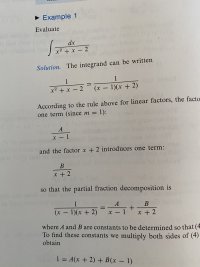Hi everyone, I have a question related to the screenshot below. In the second to last series of equations at the bottom of the image, the author chose A/(x-1) and B/(x+2). Is there a reason for this order? Why not A/(x+2) and B/(x-1)? (x+2) and (x-1) both have degree 1, so why are they not interchangeable for A and B? And more generally, is there a precedence of order for the factors of the denominator?


